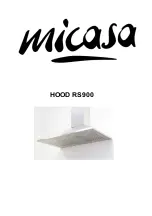
26
49-2000387 Rev. 4
Heavy, Burned-On Residue
For models with Precision Cooktop Sensor on the
left front element:
ONLY use non-scratch pads to clean
the surface of the Precision Cooktop Sensor. DAMAGE
to the sensor surface may occur if you use scrub pads
that are abrasive
.
1. Allow the cooktop to cool.
2. Use a single-edge razor blade scraper at approximately
a 45° angle against the glass surface and scrape the
soil. It will be necessary to apply pressure to the razor
scraper in order to remove the residue.
3. After scraping with the razor scraper, spread a few
drops of ceramic cooktop cleaner on the entire burned
residue area. Use the non-scratch cleaning pad to
remove any remaining residue.
4. For additional protection,
after all residue has been
removed, polish the entire
surface with ceramic
cooktop cleaner and a
paper towel.
The ceramic cooktop scraper and all recommended supplies
are available through our Parts Center. See the Accessories
and Consumer Support sections at the end of this manual.
NOTE:
Do not use a dull or nicked blade.
Metal Marks and Scratches
1. Be careful not to slide pots and pans across
your cooktop. It will leave metal markings on the
cooktop surface.
These marks are removable using the ceramic
cooktop cleaner with the non-scratch cleaning pad for
Ceramic Cooktops.
2. If pots with a thin overlay of aluminum or copper
are allowed to boil dry, the overlay may leave black
discoloration on the cooktop.
This should be removed immediately before heating
again or the discoloration may be permanent.
NOTE:
Carefully check the bottom of pans for roughness
that would scratch the cooktop.
Damage from Sugary Spills and Melted Plastic
Special care should be taken when removing hot substances
to avoid permanent damage of the glass surface
.
Sugary spillovers (such as jellies, fudge, candy, syrups) or melted plastics can cause pitting of the surface of your
cooktop (not covered by the warranty) unless the spill is removed while still hot. Special care should be taken when
removing hot substances.
Be sure to use a new, sharp razor scraper.
Do not use a dull or nicked blade.
1. Turn off all surface units. Remove hot pans.
2. Wearing an oven mitt:
a. Use a single-edge razor blade scraper to move
the spill to a cool area on the cooktop.
b. Remove the spill with paper towels.
3. Any remaining spillover should be left until the surface
of the cooktop has cooled.
4. Don’t use the surface units again until all of the
residue has been completely removed.
NOTE:
If pitting or indentation in the glass surface has
already occurred, the cooktop glass will have to be
replaced. In this case, service will be necessary.
Glass Cooktop (Cont.)
Precision Cooktop Sensor
1. Allow cooktop to cool.
2. Apply soapy water to a non-abrasive sponge and
spread across any residue on the sensor.
3. Using the sponge, rub the residue area applying
pressure as needed
4. If any residue remains, repeat the steps listed above
as needed.
5. Wipe the sensor with a wet towel or sponge to remove
any soap.
6. Dry the sensor after cleaning using dry towel.
IMPORTANT:
Make sure sensor is dry before cooking. If
sensor is not clean and dry cooking performance could
be affected. Do not use cream based cleaners, abrasive
pads or razor blades on sensor surfaces.
CARE AND
CLEANING:
Glass Cooktop
















































